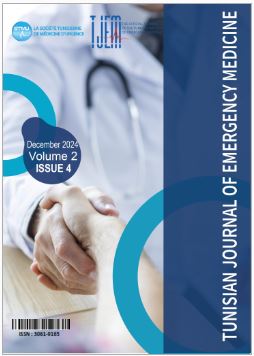Prehospital Particularities of Covid-19 infection and factors associated with its severity during the omicron variant wave (East-center of Tunisia)
DOI:
https://doi.org/10.0000/2j75dx56Keywords:
prehospital, Omicron variant wave, covid-19Abstract
Background: The Omicron variant of SARS-CoV-2, characterized by high transmissibility and
partial immune evasion, led to significant waves of COVID-19 globally. This study aimed to
evaluate the epidemiological and clinical characteristics of COVID-19 cases during the Omicron
wave in Tunisia, focusing on severity predictors.
Methods: A prospective study was conducted from January 1
st
to February 28
th
, 2022, in the
EMS03. Data were collected through patient records and follow-up interviews. COVID-19
severity was classified as mild, moderate, or severe per WHO guidelines. Predictors of severity
were identified through univariate and multivariate analyses.
Results: Among 2,948 calls received, 420 confirmed COVID-19 cases were analyzed. The mean
age was 48 years (±21.62), with 51% female. Comorbidities were present in 42.1% of cases, and 69.6% were vaccinated against COVID-19. The most reported symptoms were cough (67.5%), myalgia (61.2%), and fever (57.4%). Severe COVID-19 infection presentation was observed in
19.5% of cases, with 28.3% requiring hospitalization, 9.3% needing ICU care, and a mortality rate
of 15.5%. Predictors of severity included advanced age, male sex, comorbidities, low education
level, and lack of vaccination. Vaccinated individuals exhibited reduced severity, but severity was
not significantly associated with the number of doses or type of vaccine.
Conclusion: The Omicron wave presented predominantly symptomatic cases with milder disease
severity compared to earlier variants. However, age, comorbidities, and vaccination status
significantly influenced outcomes. Enhanced vaccination coverage remains critical in mitigating
severe COVID-19.
Downloads
Published
Issue
Section
License
Copyright (c) 2024 Tunisian Journal of Emergency Medicine

This work is licensed under a Creative Commons Attribution-NonCommercial-ShareAlike 4.0 International License.
How to Cite
Similar Articles
- Samia Meherzi, Rihab Omri, Amin khbou , Rabiaa Kaddechi , Afifa CHARFI, Management of Bell palsy: our clinical practice guideline , Tunisian Journal of Emergency Medicine: Vol. 3 No. 1 (2025): TJEM 2025: Vol.3 Issue 1
- Amira Sghaier, Marwa Toumia, Khaoula Bel Haj Ali, Adel Sekma, Kaouthar Beltaief, Zied Mezgar, Wahid Bouida, Riadh Boukef, Jamel Saad, Hamdi Boubaker, Mohamed Amine Msolli, Mohamed Habib Grissa, Semir Nouira, B-lines Ultrasonography Assessment by Nurses for the Diagnosis of Heart Failure in the Emergency Department , Tunisian Journal of Emergency Medicine: Vol. 2 No. 4 (2024): TJEM Vol2 Issue4
- Randa dhaoui, Khaoula bel Haj Ali, Adel Sekma, Sarra Sassi , Wahid Bouida, semir nouira, The challenge in diagnosing human rabies: A case report , Tunisian Journal of Emergency Medicine: Vol. 3 No. 1 (2025): TJEM 2025: Vol.3 Issue 1
- Olfa chakroun-walha, Overview of the post-night shift syndrome in the COVID-19 pandemic era: predictors in a North African sample of physicians , Tunisian Journal of Emergency Medicine: Vol. 2 No. 3 (2023): TJEM Vol2 Issue3
- Rym KARRAY, Headaches and COVID-19 Infection: Epidemiology and Outcomes in a North African Sample , Tunisian Journal of Emergency Medicine: Vol. 2 No. 2 (2022): TJEM Vol2 Issue2
- Dorra Loghmari , Compassion satisfaction and fatigue among healthcare professionals in the emergency medical services during the COVID-19 pandemic , Tunisian Journal of Emergency Medicine: Vol. 2 No. 2 (2022): TJEM Vol2 Issue2
- Houda BEN SOLTANE, Predicting diabetic ketoacidosis severity score: proposal of a therapeutic strategy adapted to the emergency department , Tunisian Journal of Emergency Medicine: Vol. 2 No. 2 (2022): TJEM Vol2 Issue2
You may also start an advanced similarity search for this article.
Most read articles by the same author(s)
- Randa dhaoui, Khaoula bel Haj Ali, Adel Sekma, Sarra Sassi , Wahid Bouida, semir nouira, The challenge in diagnosing human rabies: A case report , Tunisian Journal of Emergency Medicine: Vol. 3 No. 1 (2025): TJEM 2025: Vol.3 Issue 1
- Haifa BRADAÏ, Rabeb Mbarek, Sondes Laajimi, Dorra Loghmari, Mounir NAIJA, Atrial flutter mimicking ST-elevation myocardial infarction: A case report , Tunisian Journal of Emergency Medicine: Vol. 3 No. 1 (2025): TJEM 2025: Vol.3 Issue 1
- Sondes laajimi, haifa bradai, Nabil Chebbi, Dorra Loghmari , imen EL KISSI, Naoufel Chebili , rabeb Mbarek, Specific Features of Chest Pain in Young People treated in Prehospital Care , Tunisian Journal of Emergency Medicine: Vol. 3 No. 1 (2025): TJEM 2025: Vol.3 Issue 1
- Amira Sghaier, Marwa Toumia, Khaoula Bel Haj Ali, Adel Sekma, Kaouthar Beltaief, Zied Mezgar, Wahid Bouida, Riadh Boukef, Jamel Saad, Hamdi Boubaker, Mohamed Amine Msolli, Mohamed Habib Grissa, Semir Nouira, B-lines Ultrasonography Assessment by Nurses for the Diagnosis of Heart Failure in the Emergency Department , Tunisian Journal of Emergency Medicine: Vol. 2 No. 4 (2024): TJEM Vol2 Issue4
- Dorra Loghmari , The beneficial learning by simulation in the acquisition of non-technical skills among medical students , Tunisian Journal of Emergency Medicine: Vol. 2 No. 3 (2023): TJEM Vol2 Issue3
- Dorra Loghmari , Epidemiological and prognostic factors associated with road traffic accidents occurring in the Center East of Tunisia. , Tunisian Journal of Emergency Medicine: Vol. 2 No. 3 (2023): TJEM Vol2 Issue3
- Dorra Loghmari , Compassion satisfaction and fatigue among healthcare professionals in the emergency medical services during the COVID-19 pandemic , Tunisian Journal of Emergency Medicine: Vol. 2 No. 2 (2022): TJEM Vol2 Issue2
- Dorra Loghmari , Anevrysmal subarachnoid hemorrhage with electrocardiographic abnormalities: a case report , Tunisian Journal of Emergency Medicine: Vol. 2 No. 3 (2023): TJEM Vol2 Issue3

